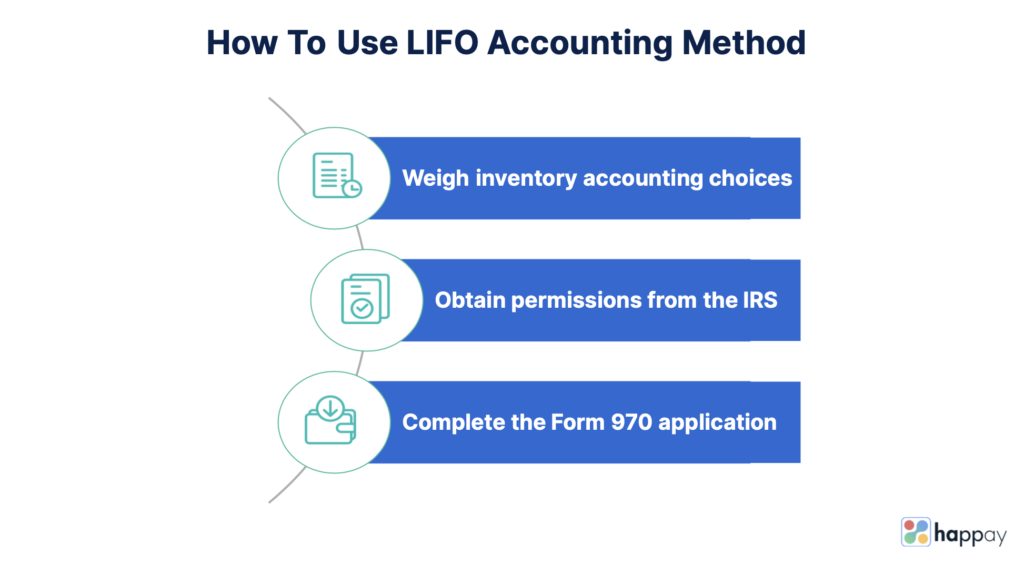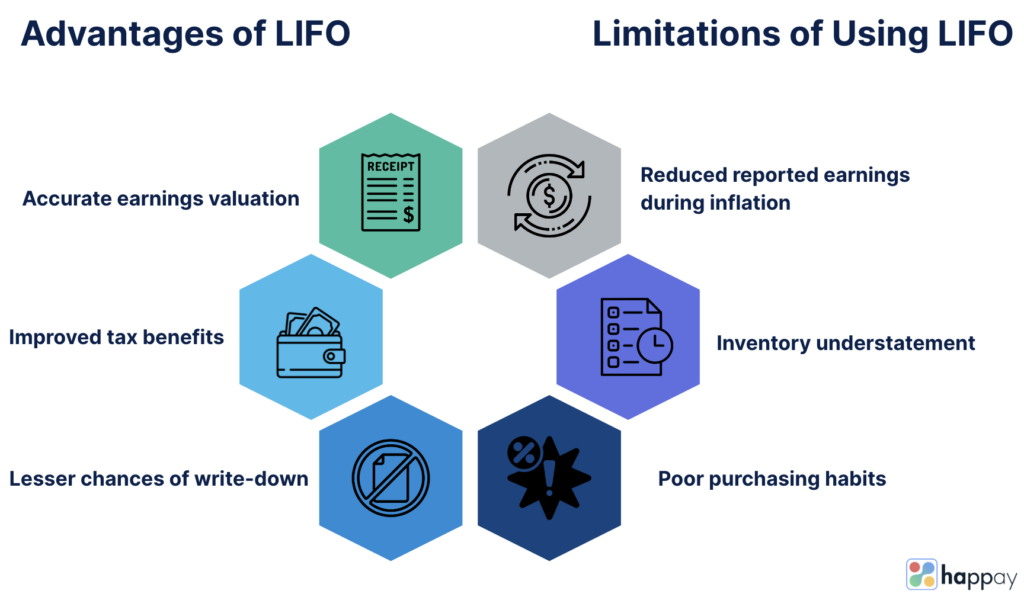Last Updated on November 28, 2025
Introduction
“Constantly take inventory of what’s important to you.” – Dave Chappelle
Effective inventory management is crucial for enterprises to stock suitable raw materials and meet market demands. They use the last in, first out (LIFO) or first in, first out (FIFO) method for inventory accounting and cost of goods sold (COGS) calculation.
LIFO is a business inventory valuation method that assumes the latest raw materials or inventories are the first items to sell during an accounting year. The assumption considers that the latest inventory is the most expensive because of steadily rising prices. Higher costs result in lower profits and reduce taxable income. When prices rise, companies use LIFO to lower taxes and match revenue to the latest costs.
The International Financial Reporting Standards (IFRS) prohibits using this accounting methodology in most countries. Only US-based companies can use it for tax filing and financial reporting. If you’re looking to simplify LIFO for accounting and supply chain teams in your organization, this article covers what it is, how it works, and best practices.
What is last In, first out (LIFO)?
The last in, first out (LIFO) is a widely used inventory accounting method. It assumes that an organization first sells the most recently acquired inventory items, saleable assets, and raw materials.
When calculating COGS and cost flow assumption, a company using LIFO records the last purchased or produced items as the ones sold first. It reports the rest of the products with lower costs as inventory. This inventory management method better suits nonperishable goods since it uses current prices to calculate the COGS.
Imagine an electronics company sources five laptops at $500 each and five more at $800 each. They sell seven laptops in the following week. Using this inventory management method, they’ll sell the last five first and then two from the old stock. Every laptop generates the same revenue, but the total cost of laptops differs based on the inventory method.
With LIFO, the total cost of laptops equals $5,000 ( 5x$800 + 2x$500). If they use first in, first out (FIFO), the total cost will be $4,100 (5x$500 + 2x$800).
As you see, LIFO is ideal for showing lower net income and higher costs during inflation. However, it may increase net income and lower costs during deflation.
Quick Read: 8 Best Inventory Management Software
Importance of LIFO
Organizations use LIFO assuming inventory costs rise over time, especially during inflationary periods. This assumption enables them to show that the cost of most recently acquired items is higher than that of earlier inventory purchases. As a result, they calculate inventory value using earlier costs and show recent costs as the cost of goods sold. This ability to calculate COGS using high-cost inventory aids companies in reporting less profitability and, as a result, paying less income taxes.
LIFO is banned in most countries since companies may use it for income tax deferral. However, the U.S. allows it under generally accepted accounting principles (GAAP).
This inventory valuation method affects financial statements in two ways:
1. Balance sheet valuation: LIFO prioritizes expensing the latest purchases first and recording outdated costs as inventory on the balance sheet. As a result, it offers lower-quality information on the balance sheet compared to other inventory valuation methods.
2. Income statement matching: This method considers recently purchased items first, so it helps organizations match COGS and recent inventory costs on income statements.
Read More: Best Free Accounting Software in 2023
When to use LIFO?
LIFO bookkeeping can be more complex as the inventory may still contain older products, leading to inaccurate COGS. Enterprises may use LIFO for one or more of the following reasons.
- Inflation: Organizations use such an accounting methodology during inflationary periods when inventory or product cost has steadily risen.
- Taxes: You may also use this inventory cost method to show less profit on the books, which reduces the corporate tax burden.
- Savings: LIFO can also be helpful when enterprises want to save money despite increasing inventory and production costs.
Why is LIFO banned under IFRS?
IFRS mandates that LIFO is not a permissible method of inventory cost calculation or recognizing cost as an expense under the International Accounting Standards (IAS) – 2.
LIFO is prohibited because it creates a misleading picture of an organization’s financial statements and profitability. Companies using this method may understate earnings to reduce taxable income and show outdated inventory valuations. Plus, they can use LIFO liquidation to sell inventory with low carrying costs and inflate earnings.
For example, ExxonMobil used LIFO to report inventory worth $11.1 billion in its 2007 financial statements. However, the report footnote mentioned the cost to acquire the same stock was $25.4 billion more than the number reported. That means they showed inventory worth $11.1 billion but worth $36.4 billion.
Another reason behind the ban is that IFRS has adopted a balance sheet approach instead of focusing on income statements. This new approach involving a statement of financial position (SoFP) requires companies to portray their financial situation according to current market conditions.
IAS-2 offers cost formula guidelines that organizations can use for assigning inventory costs. Enterprises should measure inventories at the net realizable value, the estimated selling price minus the estimated product completion cost.
The LIFO conformity requirement in the Internal Revenue Code sections 472(c) and (e)(2) states that taxpayers may not use this method for income tax purposes unless they also use it for annual inventory valuation reporting statements.
Read More: Difference Between Financial Accounting and Management Accounting: A Deep Dive
How LIFO inventory method works?
The LIFO inventory method calculates COGS assuming the recently acquired inventory will sell first. Supply chain professionals and accountants use this method to match COGS with the recent inventory cost. To find the value, multiply the current inventory cost by the inventories you sell.
Here’s a step-by-step breakdown of how it works:
- Inventory purchase: Add the recently purchased or produced items to the inventory account. Now, use these items’ latest prices which you’ll use to calculate the inventory value.
- COGS allocation: Allocate the cost of recent inventory to COGS after selling an item. As a result, you record each sale’s expense based on the latest prices.
- Ending inventory: When using LIFO, you calculate COGS based on the latest prices and the ending inventory value based on old, in-stock inventory. The result is a lower ending inventory value and higher COGS.
- Price change effect: If you’re using LIFO during a price rise, you can show lower net income by matching the oldest inventory items against current revenue.
Now, let’s look at how organizations can decide whether or not to use LIFO.
How to use LIFO?
US-based companies may opt for LIFO accounting but can stop using it only after obtaining permission from the Internal Revenue Service (IRS). That’s why it’s essential to think through before applying for LIFO. The steps below break down how to decide whether to use LIFO.

1. Weigh your choices
There’s no one-size-fits-all regarding inventory accounting. Some companies may use LIFO, while others stick to FIFO. If you fall in the first category, you must think twice, as the filing process is complex. However, LIFO is an excellent option for enterprises looking to increase savings during inflation. Start by consulting with a business tax professional and reviewing other methods before opting for this financial accounting method.
2. Obtain permission from the IRS
Once you’re sure about using this method, you’ll need to fill in Form 970 to get the necessary permission from the IRS. You can submit this form and your tax return when you use LIFO. Remember to mention how long you’ll be using this accounting method. Also, check if the IRS needs other tax and profit reporting documents.
3. Complete the application
The IRS may request different information to determine your eligibility for the LIFO method. For example, they may ask about the costing methods you’ll use besides inventory accounting. These methods include the specific goods method, inventory price index computation (IPIC) method, and dollar-value method. To better clarify your situation, consider explaining the following:
- Goods you’ll include in and exclude from the LIFO method
- Inventory valuation methods you used during previous years
Example of LIFO
McBerry Private Limited is a US-based multinational smartphone manufacturer. They started producing smartphones on June 1, 2023. By the end of July, they had sold 650 smartphones in six batches. The price of every batch varies because of varying raw material costs. Here’s what it cost them to acquire the inventory.
Date |
Quantity (in pcs.) |
Price per smartphone |
|
June 8, 2023 |
25 |
$300 |
|
June 10, 2023 |
50 |
$100 |
|
June 15, 2023 |
100 |
$150 |
|
June 19, 2023 |
150 |
$200 |
|
June 25, 2023 |
150 |
$400 |
|
June 29, 2023 |
50 |
$200 |
Mcberry Private Limited wants to calculate the cost of goods sold as of June 30, 2023. They can’t consider the recent price of $200 per smartphone. Here’s how they’ll calculate the COGS.
|
50 laptops x $200 |
$10,000 |
|
150 laptops x $400 |
$60,000 |
|
150 laptops x $200 |
$30,000 |
|
Total COGS |
$100,000 |
This example shows that Mcberry Private Limited first sells the latest inventory items. As a result, the old stock may never sell, which is the real problem of using the LIFO. But, Mcberry Private Limited benefits from reducing profits by considering the expensive costs of acquiring the latest inventory.
Also, Read: Difference Between Cost Accounting and Financial Accounting
Advantages of using LIFO
Organizations using LIFO often do so to show higher COGS, a lower leftover inventory balance, and minimize tax liabilities. Below are the other benefits of using this method.
1. Accurate current earnings valuation
Since the LIFO method matches the latest inventory costs with current revenues, enterprises use it to measure current earnings effectively.
Other methods like FIFO compare current revenues against old inventory costs. As a result, an organization may see inventory profit or paper profit, which occurs when the inventory replacement cost is higher than the inventory cost you match against revenues. With FIFO, this inventory profit shows higher profit and lower COGS in an inflationary period.
Opting for LIFO enables companies to prevent profit overstatement and COGS understatement. The result is increased accuracy of inventory profits and earnings in the books.
2. Improved tax benefits and cash flow
Some organizations also use the LIFO method to take advantage of tax benefits. For example, they can show lower profit and minimize income taxes using last in, first out during inflations. Reducing tax liabilities helps them improve forecasted cash flow as well.
3. Lesser chances of a future write-down
Write-downs denote the reduced book value of inventories, especially when the fair market value goes below the carrying inventory cost. Since LIFO enables companies to sell the latest stock purchased at a higher price first, they are less likely to see the effect of future price declines. As a result, these organizations minimize the chances of future write-downs.

Limitations and challenges of LIFO
Many countries don’t use the LIFO valuation method because it is incompatible with international financial reporting standards. Plus, organizations may end up with older, damaged inventory items with this valuation method. Below are other major drawbacks organizations may experience with LIFO.
1. Reduced reported earnings during inflation
Enterprises using the LIFO method show less profitability and earnings during inflation. Therefore, they may be unable to increase the stock price and get buy-ins from investors.
2. Inventory understatement
The LIFO method also understates inventory since it calculates the balance sheet inventory based on the oldest items. As a result, a company may end up understating its working capital than it is in reality.
3. Poor purchasing habits
Some enterprises use LIFO liquidation to show that it has sold more inventory than they purchased. Consequently, they experience higher reported income and tax payments for a period. Under such circumstances, companies may buy bulk stocks to show higher revenues. This habit of bulk buying leads to poor purchasing habits.
Now, let’s explore other inventory accounting methods.
Read More: Cash Accounting: What is it?, Benefits, Methods & How it Work?
How LIFO differs from other inventory valuation methods?
The difference between all valuation methods and LIFO lies in how the LIFO method calculates COGS and the ending inventory value.
The average cost inventory (AVCO) or weighted-average method calculates the inventory cost by dividing total COGS by the total number of items purchased or produced. It predicts a stable COGS and ending inventory value by considering all inventories.
On the other hand, the first in, first out method considers that recently purchased items are still in stock. It calculates COGS based on the oldest inventories, meaning the first items purchased are the first to be calculated in the revenue.
The key difference between LIFO and other methods is that it assigns the last inventory items to COGS, assuming that older items are still in stock.
Now, let’s go over the key differences between LIFO and FIFO.
Read More: What is Accrual Accounting: Meaning, Principles and Example
LIFO vs. FIFO: key differences
The difference is that LIFO assumes that the latest inventories are the first items to sell, whereas FIFO considers that the oldest inventory unit sells first.
The last in, first out, or LIFO method calculates COGS using the latest inventory prices. It assumes that the older inventory items will be in stock. Organizations use this inventory method to reduce profits and taxes when raw material costs or production prices increase constantly.
You can calculate LIFO using the following formula:
Cost of goods sold = (the number of latest inventory items x their value) + (remaining inventory items from second purchase x their value)
The first in, first out, or FIFO method assumes the first inventory or goods will sell first and become part of the cost of goods sold. Companies selling perishable items like designer clothes or food products use this method to stay profitable despite economic fluctuations.
Here’s how to calculate COGS using FIFO:
Cost of goods sold = (the number of old inventory items x their value) + (remaining new inventory items from recent purchases x their value)
LIFO |
FIFO |
|
|
Meaning |
Last in, first out |
First in, first out |
|
Assumption |
The latest inventory is the first to sell |
The earliest inventory is the first to sell |
|
Stock in hand |
The oldest inventory |
The latest inventory |
|
Current market prices shown by |
COGS |
Cost of unsold stock |
|
Restrictions |
Not recommended by IFRS |
None |
|
Inflation |
Lower income tax |
Higher income tax |
|
Deflation |
Higher income tax |
Lower income tax |
|
Ideal for |
Retailers, car dealers, and gas & oil companies |
Food product manufacturers, grocery stores, and fashion design companies |
Is LIFO better than FIFO?
LIFO accounting helps organizations save taxes and show lower profitability when product costs increase. The FIFO method results in lower COGS and higher inventory under similar circumstances. However, FIFO works better when planning to invest in inventory amidst rising prices. LIFO is better for investing when prices fall, as it lets you sell expensive items first.
Best practices for managing LIFO inventory
Managing LIFO inventory is easier with accurate record-keeping, cost flow assumption, inflation monitoring, and budgeting.
- Consistent record-keeping and inventory counting: Recording sales, inventory purchases, and inventory levels regularly helps you stay on top of inventory accounting. Also, consider checking inventory items physically to prevent discrepancies in the future.
- Cost flow assumption rationale: Clearly understand why you’re using LIFO and how it impacts financial statements. That way, you’ll be better prepared to answer financial reporting-related questions during audits.
- Inflation monitoring: LIFO is beneficial for showing low profits during inflationary periods. That’s why tracking inflationary trends and analyzing their impact on your organization’s financial performance is important.
- Tech stack: Using the right inventory management software is crucial for supporting your LIFO accounting needs.
Consider consulting a financial advisor prior to switching inventory accounting methods. However, it’s best that you periodically check if switching to other methods will be better for your organizational needs.
FAQs
The last in, first out, or LIFO is an inventory accounting method that considers an organization is likely to sell the last acquired or purchased inventory or product first.
Most countries except the U.S. have banned LIFO accounting standards because companies can misuse it to distort financial statements, understate profitability, and lower income taxes.
LIFO reserve is an accounting term. It measures the difference between the cost of inventory calculated using LIFO and FIFO methods. This metric helps businesses better understand tax liabilities of each method and create financial statements accordingly.
Some organizations prefer LIFO over FIFO because it helps them report higher COGS, lower profitability, and minimize income taxes.
The first unit produced is the first unit used in process costing. That’s why process costing uses the FIFO method instead of LIFO.
The key difference is LIFO assumes the last items are the first to sell, whereas FIFO considers the oldest products from the beginning inventory batch to sell first.
Organizations use LIFO to calculate inventory value assuming that the most recently produced inventory is the first to sell.










Discussion about this post